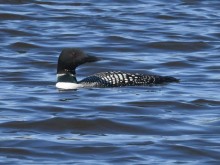The Loon & Diver Stewardship Working Group of which Journey North is an active member has created this informative fact sheet to be distributed widely by individuals and organizations interested in loon conservation and protection. Please help Journey North spread these important messages.
Download the Loon Fact Sheet in either English or French. (Spanish translated fact sheet coming soon.)
Egg Shell and Membrane Removal
After the hatch of their first chick, it is very common for adult loons to remove the membrane from the first hatched egg and any attached large pieces of eggshell from their nest. This behavior has been widely documented here in New Hampshire, both on LPC's Live Loon Cams (see video below) and by wildlife photographers, as well as by biologists in the field. Why do loons remove shells and membranes from their nests when many other bird species do not perform this behavior?
Body Adaptations
Loons have evolved to be highly specialized for life in the water. They have a number of adaptations that minimize resistance and reduce drag, making them fast and agile when swimming and diving and enabling them to be excellent fishers. Anyone who has seen a loon in the water knows how impressive their swimming ability is—it is not uncommon for a loon to dive and resurface hundreds of feet away from where it was last seen in a short amount of time.
Courtship
As far as we are currently aware, the members of loon pairs do not spend the winter together. They typically migrate separately in the fall, winter separately, and then arrive back to breeding lakes at different times (the males tend to arrive a bit earlier than the females).
The "Other" Loons: Yellow-billed Loon
Though we primarily work with Common Loons here in New Hampshire, there are actually 4 other loon species that exist in the world today! In January and February, we talked about Red-throated loons, Arctic Loons, and Pacific Loons. This month we are wrapping up this series with some facts about the final species, the Yellow-billed Loon (Gavia adamsii).



